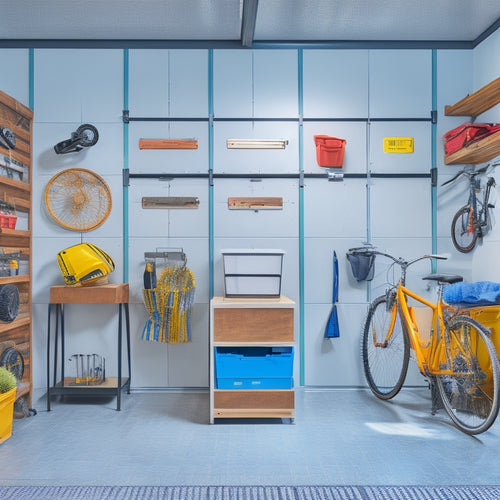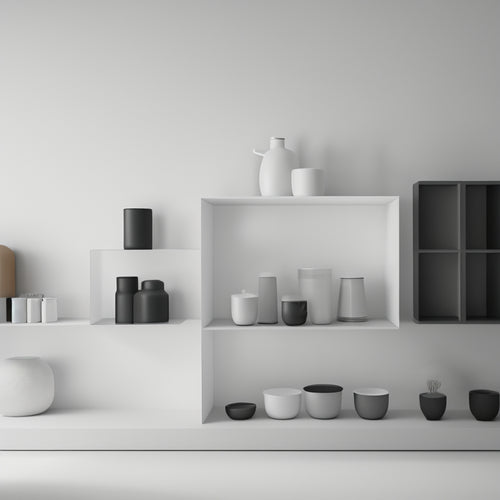
Boost Workshop Efficiency With Strategic Layout Design
Share
By strategically designing your workshop layout, you can boost efficiency by allocating specific tasks to distinct zones, streamlining workflow, and optimizing space utilization. Position machines and workstations to minimize travel distances and worker movement, and focus on strategic tool placement for efficiency. Maximize storage space by utilizing vertical areas, and implement effective inventory management systems. Analyze your workflow to identify bottlenecks, and consider a flexible layout design to adapt to changing needs. By implementing these strategies, you can eliminate operational inefficiencies and notably increase productivity. Now, discover how to tackle specific pain points and maximize your workshop's potential.
Key Takeaways
• Dividing the workshop into distinct zones and allocating specific tasks to each area streamlines workflow and reduces operational inefficiencies.
• Strategically positioning machines and workstations minimizes travel distances and worker movement, optimizing space utilization and increasing productivity.
• Focusing on strategic tool placement for efficiency optimizes workflow paths and reduces downtime by placing high-usage tools near the center.
• Implementing effective storage optimization strategies, such as vertical shelving units and labelled bins, maximizes storage capacity and reduces search time.
• Conducting a workflow analysis to identify bottlenecks and implementing congestion solutions, such as rearranging equipment, enhances visibility and accessibility.
Optimizing Workflow With Zone Allocation
Optimizing Workflow With Zone Allocation
By dividing your workshop into distinct zones, you can allocate specific tasks to each area, thereby streamlining your workflow and reducing operational inefficiencies. This zone allocation strategy enables you to optimize space utilization, ensuring that each area is utilized to its maximum potential. As a result, worker productivity increases, and you can complete tasks more efficiently.
Zone efficiency is critical in workflow optimization. By assigning specific tasks to each zone, you can minimize unnecessary movement of workers and equipment, reducing downtime and increasing overall productivity.
For instance, you can designate a zone for material storage, another for fabrication, and another for assembly. This clear segregation of tasks enables workers to focus on their specific responsibilities, reducing confusion and errors.
Designing for Reduced Travel Distances
When designing your workshop's layout, you'll want to strategically position machines and workstations to minimize travel distances and reduce worker movement.
By optimizing machine placement, you can greatly cut down on the time spent walking between tasks, freeing up more time for actual work.
Optimize Machine Placement
By strategically situating machines in your workshop, you can significantly diminish travel distances, thereby enhancing productivity and efficiency. This optimization is pivotal for machine efficiency, as it enables workers to complete tasks swiftly and effectively.
To achieve prime machine placement, consider the following layout optimization strategies:
-
Group similar machines together: This diminishes travel distances between tasks and enables workers to complete akin tasks in one area.
-
Position high-usage machines centrally: This guarantees that frequently used machines are easily accessible, reducing travel time and escalating workspace productivity.
-
Orient machines to minimize obstruction: This averts workers from having to navigate around substantial equipment, reducing congestion and enhancing equipment utilization.
- Leave sufficient space for material handling: This secures that materials can be effortlessly moved between machines, reducing congestion and amplifying overall efficiency.
Minimize Worker Movement
Designing your workshop layout to minimize worker movement can significantly decrease travel distances, allowing you to allocate more time and energy to actual production. By optimizing your spatial organization, you can notably boost worker productivity.
When workers spend less time moving around, they can focus on tasks that add value to your products or services.
To achieve movement efficiency, start by analyzing your workshop's workflow. Identify the most frequently used tools, equipment, and workstations, and group them together to reduce travel distances.
Implement a layout that allows workers to move in a logical and sequential manner, minimizing backtracking and crisscrossing. Consider the 'work triangle' concept, where the most frequently used items are placed at the vertices of a triangular path, allowing workers to move efficiently between tasks.
Strategic Tool Placement Techniques
When designing your workshop's layout, you'll want to focus on strategic tool placement to maximize efficiency.
To do this, you'll need to optimize your workflow paths, ensuring that tools are placed in a logical sequence that mirrors the tasks you're performing.
Optimize Workflow Paths
What's the most efficient route for your team to follow as they move through the workshop, and how can you optimize it by strategically placing tools and equipment along the way?
By streamlining your workflow paths, you can notably reduce travel time, increase productivity, and enhance overall layout efficiency.
To achieve this, focus on workflow optimization by identifying the most frequently used tools and equipment and placing them in close proximity to each other. This will diminish the need for unnecessary walking distances, allowing your team to complete tasks more efficiently.
Additionally, consider the following strategies to optimize your workflow paths:
- Place high-usage tools near the center of the workshop to minimize travel time.
- Designate specific zones for specific tasks to reduce congestion and improve space utilization.
- Implement a 'clean as you go' policy to prevent clutter and maintain a safe working environment.
- Consider the 'golden zone' concept, where frequently used items are placed between waist and shoulder height to reduce bending and straining.
Zone-Based Tool Allocation
By dividing your workshop into distinct sections, each dedicated to a specific task or process, you can strategically allocate tools and equipment to maximize efficiency and reduce workflow congestion. This section-based tool allocation method enables you to optimize tool efficiency by placing frequently used tools in easy-to-access locations, minimizing travel time and reducing fatigue.
In each section, allocate tools and equipment based on the specific task requirements. For example, a welding section might have a dedicated area for welding machines, safety gear, and metal preparation tools. This organized setup streamlines task allocation, allowing you to complete tasks quickly and efficiently.
By grouping similar tasks together, you can also identify opportunities to combine or eliminate steps, further optimizing productivity. Effective workspace organization is crucial to achieving this level of productivity optimization. Make sure that each section is well-lit, ventilated, and has adequate storage for tools and materials.
Maximizing Vertical Storage Space
You can greatly increase your workshop's storage capacity by optimizing the often-underutilized vertical space above workbenches, shelving units, and other equipment. This is where vertical space utilization comes into play, allowing you to make the most of your workshop's ceiling height.
By implementing effective storage optimization strategies, you can free up valuable floor space and reduce clutter.
Here are some space-saving solutions to explore:
-
Install overhead storage racks for infrequently used items, such as seasonal decorations or out-of-season equipment
-
Use wall-mounted shelves or pegboards to hang tools, accessories, and other essentials
-
Invest in vertical shelving units that can be easily accessed with ladders or step stools
- Suspend bins, baskets, or containers from the ceiling to store small parts, supplies, or materials
Streamlining Workbench Organization
When organizing your workbench, you're tasked with making the most of a limited space. You'll need to allocate essential tools in a way that optimizes your workflow, and implement storage systems that keep frequently used items within easy reach.
Essential Tool Allocation
Efficiently allocating essential tools on your workbench minimizes motion waste, reduces fatigue, and increases productivity. By strategically placing tools in high-traffic areas, you can reduce the time spent searching for them, allowing you to focus on the task at hand. This thoughtful approach to tool organization also helps maintain equipment efficiency, as tools are more likely to be properly maintained and serviced when they're easily accessible.
To optimize your tool allocation, consider the following key factors:
-
Frequency of use: Place frequently used tools in easy-to-reach locations to reduce motion waste.
-
Tool size and weight: Store larger, heavier tools near the floor or on lower shelves to prevent straining and fatigue.
-
Task-specific zones: Designate specific areas for specific tasks, such as a metalworking zone or a woodworking zone, to reduce tool clutter and improve workflow.
- Personal ergonomics: Position tools to accommodate your natural work posture and movement patterns, reducing discomfort and fatigue.
Optimized Storage Systems
By implementing optimized storage systems, a workshop can reclaim up to 30% of its floor space, greatly streamlining workbench organization and paving the way for smoother workflows. As you design your workshop's layout, consider the importance of space utilization and inventory control. A well-organized storage system enables you to quickly locate tools and materials, reducing downtime and increasing productivity.
| Storage Solution | Benefits | Implementation Tips |
|---|---|---|
| Vertical shelving units | Maximize ceiling height, free up floor space | Install shelves near frequently used workstations |
| Labelled bins and containers | Easy identification, reduced search time | Use clear labels and categorize contents |
| Mobile storage carts | Flexibility, easy access | Place near workbenches, consider locking mechanisms |
| Overhead storage racks | Secure storage, minimize floor clutter | Install near entrances, consider weight capacity |
Efficient Inventory Management Systems
You can optimize your workshop's inventory management system by implementing a centralized tracking process that accounts for every item, from raw materials to finished products. This allows you to keep tabs on what's in stock, what's running low, and what needs to be reordered.
With automated inventory tracking, you can reduce stockouts, overstocking, and waste, freeing up space and resources for more important things.
To take your inventory management to the next level, consider the following strategies:
-
Implement a first-in, first-out (FIFO) system to guarantee that older items are used before they expire or become obsolete
-
Designate specific areas for different types of inventory, such as raw materials, work-in-progress, and finished goods
-
Use vertical space to maximize storage capacity and minimize floor clutter
- Implement a regular cycle counting process to detect and correct inventory discrepancies
Minimizing Bottlenecks and Congestion
Sixty percent of workshop inefficiencies stem from bottlenecks and congestion, which can be greatly reduced by rethinking your workshop's layout and workflow. To identify bottlenecks, you'll need to conduct a thorough workflow analysis, mapping out each process and identifying areas where production slows down or comes to a halt. This will help you pinpoint where congestion occurs and why.
By analyzing your workflow, you can implement congestion solutions such as rearranging equipment, optimizing workflow sequences, and streamlining tasks.
For instance, you might consider implementing a 'U-shaped' production line to reduce walking distances and improve communication among team members. Alternatively, you could implement a 'cell-based' production layout, where workers are grouped into focused teams to tackle specific tasks.
Enhancing Visibility and Accessibility
How can strategic placement of equipment and workstations optimize your line of sight and reduce navigation obstacles in the workshop?
By carefully positioning your equipment and workstations, you can create a clear path for yourself and your team to move around the workshop efficiently. This is especially important in areas where heavy machinery or large equipment is used.
To enhance visibility and accessibility, consider the following:
-
Position equipment and workstations away from corners and narrow aisles to reduce congestion and improve navigation.
-
Install shelving and storage units that are easy to access and don't obstruct your line of sight.
-
Enhancing lighting by installing task-specific lighting and improving ventilation by placing vents and fans strategically can also improve visibility and reduce eye strain.
- Place frequently used tools and materials in easy-to-reach locations to reduce walking distances and increase productivity.
Creating a Flexible Layout Design
By incorporating modular and movable components into your workshop layout, you'll be able to adapt quickly to changing project requirements and optimize your workflow. This flexibility allows you to reconfigure your layout as needed, reducing downtime and increasing productivity.
A modular workstation, for instance, can be easily rearranged to accommodate different tasks or projects, streamlining your process and reducing waste.
In a lean manufacturing environment, flexibility is key to success. By incorporating movable components, you can eliminate unnecessary steps and reduce the distance between workstations, further optimizing your workflow. This not only saves time but also reduces fatigue and improves overall job satisfaction.
Implementing a Maintenance-Friendly Layout
You can further enhance your workshop's efficiency by designing a layout that simplifies maintenance tasks, reducing downtime and getting your team back to work quickly. By doing so, you'll be able to schedule maintenance more effectively, allowing your team to focus on other tasks.
A well-planned layout should prioritize equipment accessibility, ensuring that maintenance personnel can easily reach and service equipment.
Here are some key considerations to keep in mind:
-
Locate equipment with high maintenance needs in accessible areas, reducing the time and effort required for maintenance tasks.
-
Leave sufficient space around equipment for easy access and to prevent clutter buildup.
-
Group similar equipment together, streamlining maintenance tasks and reducing travel time between machines.
- Incorporate safety considerations, such as emergency exit routes and fire suppression systems, into your layout design.
Frequently Asked Questions
How Often Should I Reassess and Adjust the Workshop Layout Design?
You should reassess and adjust your workshop layout design regularly, ideally every 6-12 months, to guarantee efficient workflow and maximize productivity levels, making design adjustments as necessary to maintain peak efficiency.
What Are the Most Common Layout Design Mistakes to Avoid?
You're a million times more likely to succeed if you avoid common layout design mistakes! Don't forget to prioritize space utilization and workflow optimization, while also considering safety and ergonomic design principles to maximize efficiency.
Can a Strategic Layout Design Improve Employee Morale and Job Satisfaction?
You'll find that a well-planned layout can boost employee engagement, as it improves workflow, reduces stress, and increases productivity benefits, ultimately leading to higher job satisfaction and a more motivated workforce.
How Do I Balance Layout Design With Existing Equipment and Infrastructure?
You'll need to assess your equipment placement to optimize workflow, ensuring it integrates seamlessly with existing infrastructure, and strategically utilize space to maximize efficiency without compromising functionality.
What Metrics Should I Track to Measure Layout Design Effectiveness?
Are you merely rearranging equipment or truly optimizing your workspace? You'll know by tracking space utilization, workflow optimization, and productivity metrics, as well as gathering employee feedback to guarantee your design decisions serve the team's needs.
Related Posts
-

3 Pro Garage Organization Ideas to Try Now
You can alter your garage from cluttered chaos to organized oasis with three pro garage organization ideas. First, op...
-

Small Shelving Options for Tight Spaces
You're surrounded by tight spaces in your home, and you need clever shelving solutions that optimize storage without ...
-

What Size Rolling Storage Bin Do I Need
To determine the ideal size of your rolling storage bin, you'll need to measure your storage space accurately, consid...


